Mastering low competition keywords will transform your SEO efforts and increase your online visibility.
This article will teach you how to find and use these low competition keywords.
But first, let’s review some keyword basics.
In This Article
Why Base Content on a Keyword?
Every page that ranks well does so in relation to a search query.
A search query, or keyword, is what users type into search engines (or speak into hands-free devices like Google Home) to retrieve information.
A keyword can be a single word or a phrase.
Here are some examples.
- jane austen
- cheap car insurance quotes
- korean tacos near me
- best electric guitars for beginners
- how to fix frozen pipes
- 19th-century icelandic poets
- Men’s gray silk suits on sale

The first step in ranking well is to decide what keyword you want to rank for before you create your page content. In SEO, we call this the focus keyword or focus keyphrase.
You can think of the target keyword as the main topic of your page.
Choosing your main topic helps you keep your web page focused and well-structured.
This approach also reminds you what your ranking goal is. As you’ll soon see, selecting a keyword makes optimizing the page for SEO much easier.
Remember: To ensure your page ranks well, you’ll need to know what keyword you want it to rank for.
And that brings us to low competition keywords.
What Are Low Competition Keywords?
Some keywords are nearly impossible to rank for, while others are easy.
The latter are called low competition keywords.
These keywords tend to be long-tail keywords, meaning they’re specific, not broad.
Long-Tail Keywords vs. Short-Tails
To understand what a long-tail keyword is, let’s compare it to a short-tail keyword.
- Short-tail keywords are broad, and the intent is vague.
- Long-tail keywords are specific with clear intent.
Let’s see the difference.
| Short-tail keywords | Long-tail keywords |
| insurance | cheap car insurance quotes no deposit florida |
| tacos | korean tacos near me |
| asphalt | driveway paving and sealing |
| flooring | brazilian teak hardwood flooring |
The appeal of choosing low competition keywords is obvious. Instead of wasting resources creating content that never ranks, you can zero in on easy keywords and start getting quality traffic.
But how do you find out which keywords are hard or easy?
This is where keyword research software comes in. Before we show you how to find low competition keywords, there’s 1 more thing to cover: keyword intent.
What is Keyword Intent?
Behind every keyword, there’s discernible intent. The more detailed the query, the clearer the searcher’s intent is.
Keyword research software conveniently labels keywords according to 4 intent types.
- I is for Informational: The searcher is gathering general information and has no buying intent.
- N is for Navigational: the intent is to find a particular brand or website (e.g., “Home Depot”).
- C is for Commercial: the searcher is comparing products or services often with a goal of buying in the near term (e.g., “geico vs progressive”). Because they have a problem to solve, these searchers also may look for “How to” content. And they’re looking for product reviews.
- T is for Transactional: the searcher is ready to buy and may search for information on purchasing, shipping, discounts, guarantees, and so on. An example is “book a cruise from Tampa.”
We recommend focusing on long-tail keywords with low difficulty scores and commercial or transactional intent.
That means keywords that are easy to rank for and attract searchers with buying intent.
You’ll likely need to include some informational content in your strategy, too. But if you focus on informational keywords that are hard to rank for, you’ll increase the cost of customer acquisition and delay growth.
Now, let’s learn how to use keyword research tools to find easy-to-rank-for keywords.
How to Find Low Competition Keywords
Keyword research tools like Semrush and Ahrefs allow you to enter a keyword and see that keyword’s difficulty score and intent.
We’ll use Semrush for this tutorial, but Ahrefs is just as easy to use.
Step 1. Create a free Semrush account
First, create a Semrush account. You can sign up for a 7-day free trial and cancel anytime.
Stay logged into your new account.
Step 2: Check Keyword Difficulty Scores
In the left-hand column, click on Keyword Overview.
Enter your keyword and click Search.
Our tutorial example is of a small business that sells men’s and women’s bomber jackets. The business specializes in aviation-style jackets made of real or faux leather with fur or faux-fur trim.
In addition, this business sells bomber jackets with specialty linings, like World War 2 flight escape maps. And they sell U.S. military-style aviator jackets, including the A-2 style.
So we’ll start by adding “aviator bomber jacket” into the Keyword Overview.
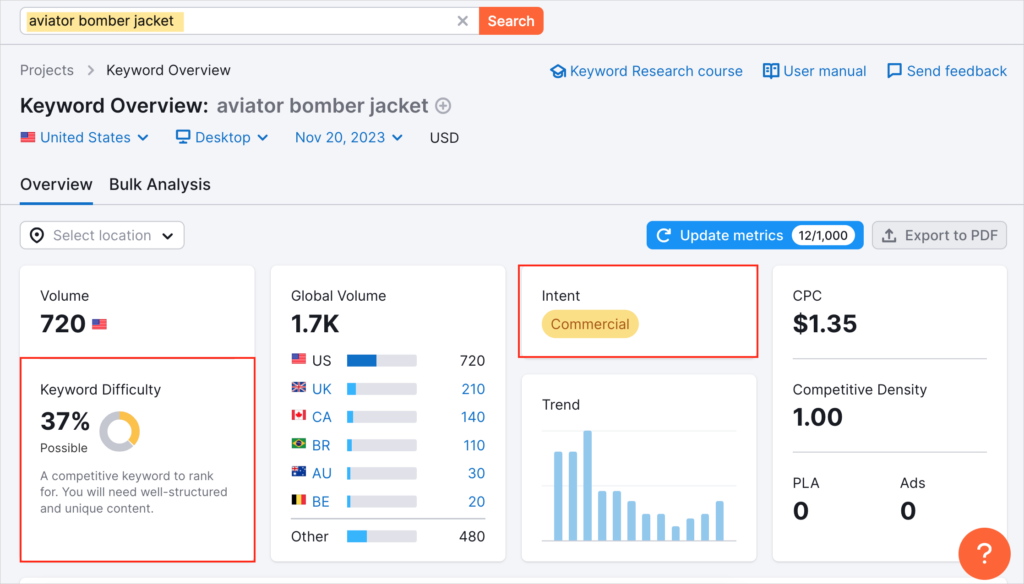
The keyword difficulty score is “Possible.” And the intent is “Commercial.” This keyword looks promising.
Can we find related keywords that are “Easy” or “Possible” to rank for and that have commercial or transactional intent?
Step 3: Use the Keyword Magic Tool
Just click Keyword Magic in the left column to get related keywords.
We instantly get over 230 related keywords.
Click the KD% column twice to sort these in ascending order of difficulty.
We want to focus on those that have the lowest scores. And remember, we want keywords with commercial (“C”) or transactional (“T”) intent.
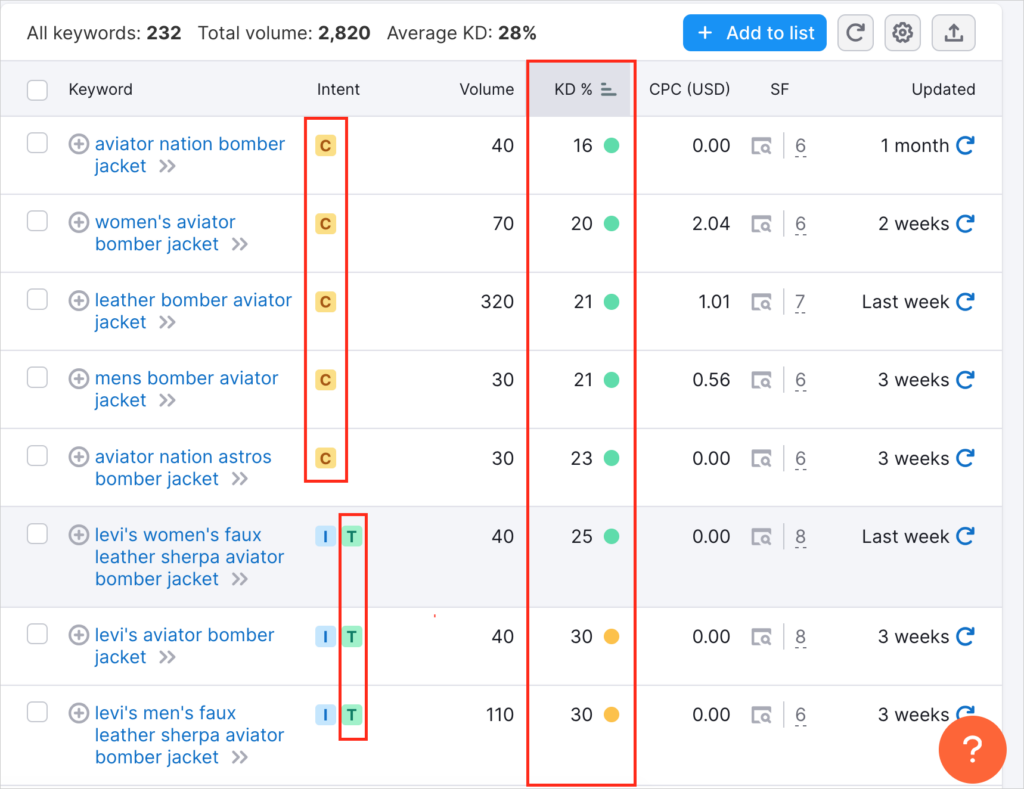
We’ve reviewed the list and chosen the following as possible keywords to create pages on.
| Keyword | KD% score | Intent |
|---|---|---|
| Aviator bomber jacket | 37% – “Possible” | Commercial |
| Women’s aviator bomber jacket | 20% – “Easy” | Commercial |
| Leather bomber aviator jacket | 21% – “Easy” | Commercial |
| Mens bomber aviator jacket | 21% – “Easy” | Commercial |
Now, we’ll run the broad term “bomber jacket” through the Keyword Magic Tool to get more keyword ideas that are niched and easy to rank for.
Here are the ones we select to consider.
| Keyword | KD% score | Intent |
|---|---|---|
| B 52 bomber jacket | 0% – “Very easy” | C |
| Black bomber jacket with fur hood | 0% – “Very easy” | T |
| Bomber jacket map lining | 0% – “Very easy” | C |
| Mink fur bomber jacket | 0% – “Very easy” | C |
| Mink bomber jacket womens | 0% – “Very easy” | T |
| Hooded leather bomber jacket | 3% – “Very easy” | T |
| Grey leather bomber jacket | 3% – “Very easy” | C |
| Brown leather bomber jacket vintage | 4% – “Very easy” | C |
| Pink leather bomber jacket | 5% – “Very easy” | C |
| Cropped leather bomber jacket | 6% – “Very easy” | C |
| Leather World War 2 bomber jacket | 12% – “Very easy” | C |
| Oversized black leather bomber jacket | 13% – “Very easy” | C |
| Distressed leather bomber jacket | 14% – “Very easy” | C |
| Lambskin bomber jacket | 16% – “Very easy” | C |
| A2 flight jacket | 34% – “Possible” | C |
By using Keyword Overview and the Keyword Magic tool, you can find thousands of keywords related to your niche that are rated “Very easy,” “Easy,” or “Possible” to rank for.
Understanding Search Volume
One of the most common mistakes new marketers make is to only target keywords with high search volume.
Search volume is an estimate of monthly searches conducted for a keyword. In Semrush, you’ll see the search volume estimate listed with each keyword.
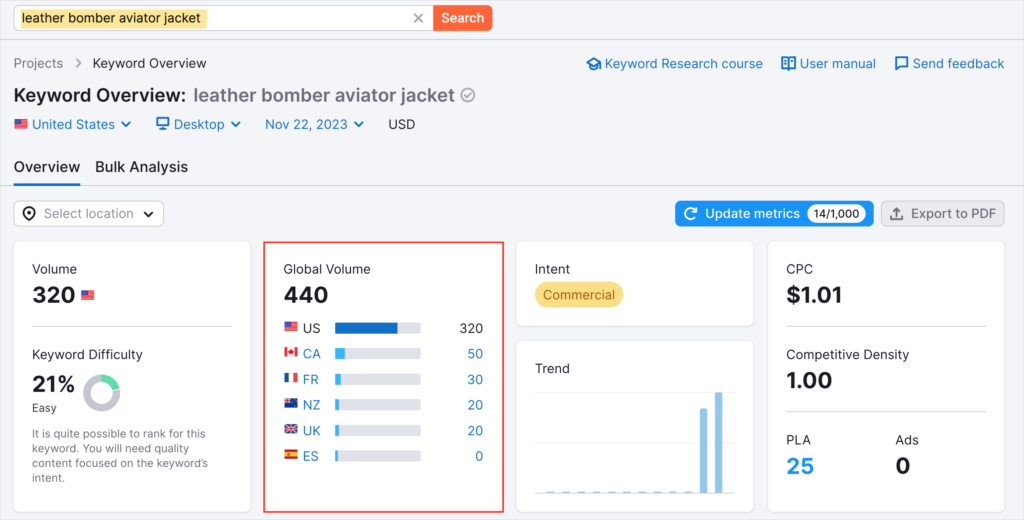
In the example above, “leather bomber aviator jacket” is estimated to get around 320 monthly searches in the U.S. and 440 globally.
That might not sound like much. But keep in mind the following.
- Informational keywords often have higher volume but don’t convert because searchers don’t have buying intent.
- Commercial and transactional terms attract shoppers.
Also, you don’t need a lot of traffic to earn revenue. You do need qualified traffic.
Just as in a brick-and-mortar store, lots of foot traffic doesn’t make up for lack of sales.
Now, when it comes to choosing from similar low competition keywords, it’s fine to pick those with higher search volume.
Review the Top-Ranking Articles
When researching keywords in Semrush, also check the top-ranking pages to see their estimated traffic.
Looking at the top 4 ranking pages for “leather bomber aviator jacket,” we see that their respective monthly search traffic is:
| Rank on Google | Page | Search Traffic |
|---|---|---|
| #1 | Amazon product page | 1.4k |
| #2 | CockpitUSA.com | 4.2k |
| #3 | TheJacketMaker.com | 1.3k |
| #4 | TopGunStore.com | 3.1k |
So why the disparity between Semrush’s estimated monthly search volume and the traffic these pages are getting?
The pages rank for more than 1 keyword, which is common in SEO.
For example, CockpitUSA.com’s page ranks for 350+ keywords, with over 50 of those being in the #1 slot on Google.
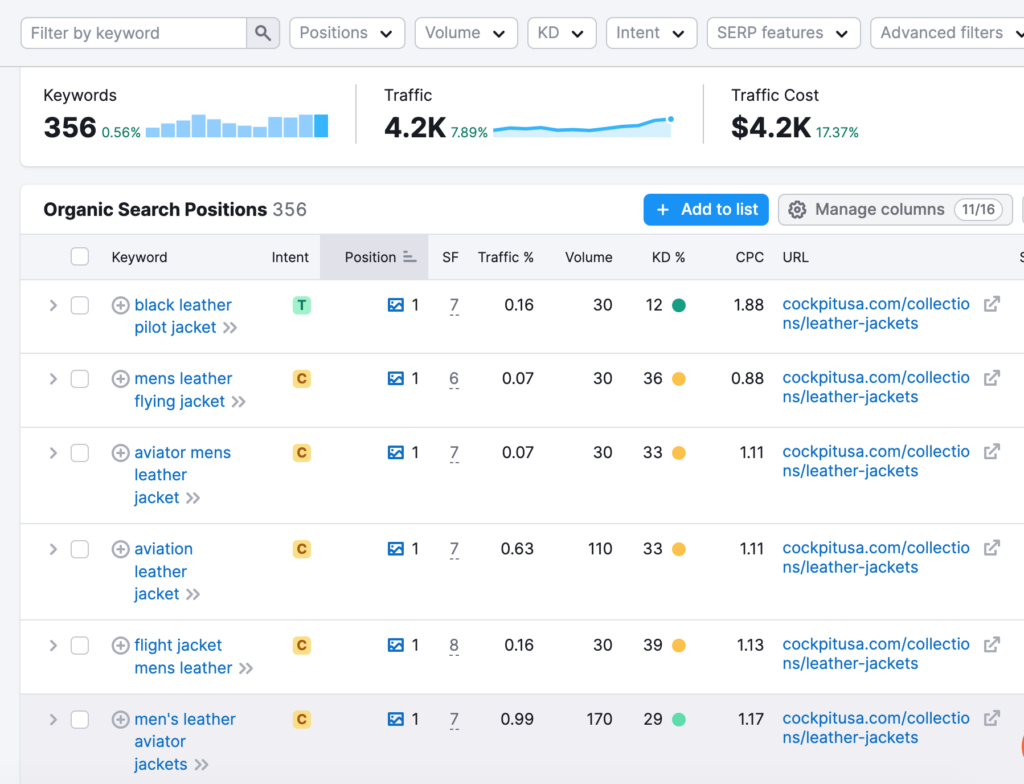
That’s unsurprising since CockpitUsa.com is an established brand and this is their landing page for all of their leather jackets.
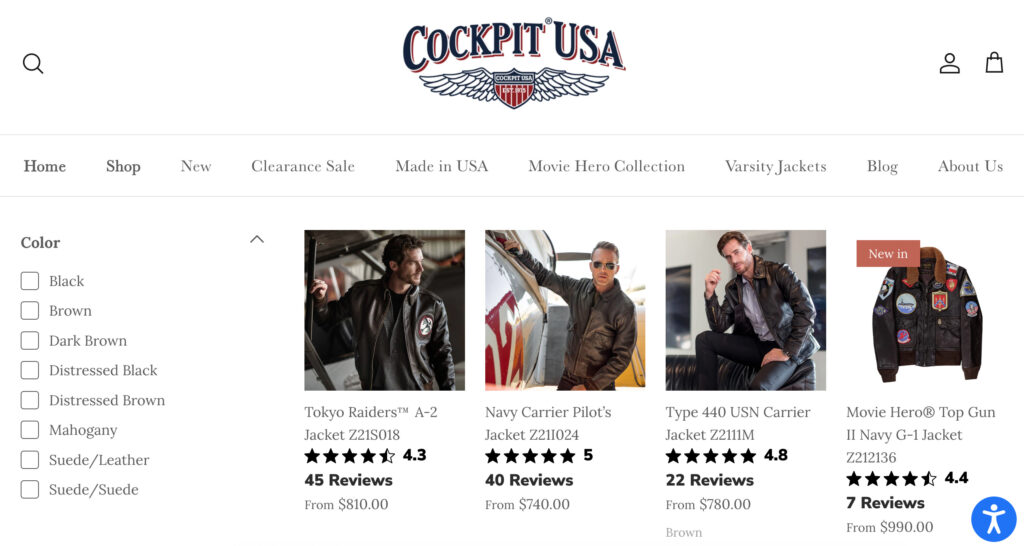
Takeaway: Make it a habit to check the competition for a keyword before creating a product page or article on it. You may discover additional keywords you want your page to rank for, or you might change your mind about the type of page you create.
Now, let’s look at how you can analyze your competitor’s keywords to gain market share.
Keyword Gap Analysis: How to Get Low Competition Keywords from Competitors
In this section, you’ll learn how to find keywords that your competition is ranking for but that you’re not.
Filtering these by keyword difficulty score, we’ll choose some keywords we want to target.
For this exercise, imagine that topgunstore.com wants to snag some of cockpitusa.com’s keywords.
We log into Semrush and click Keyword Gap in the left-hand navigation column.
We enter the topgunstore.com URL and cockpitusa.com as a competitor. Then click Compare.
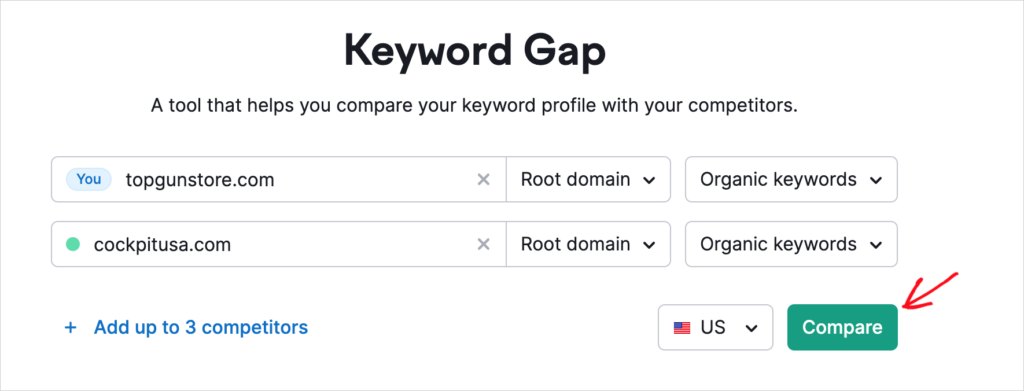
Now, you’ll see filters and a Venn diagram representation of keywords.
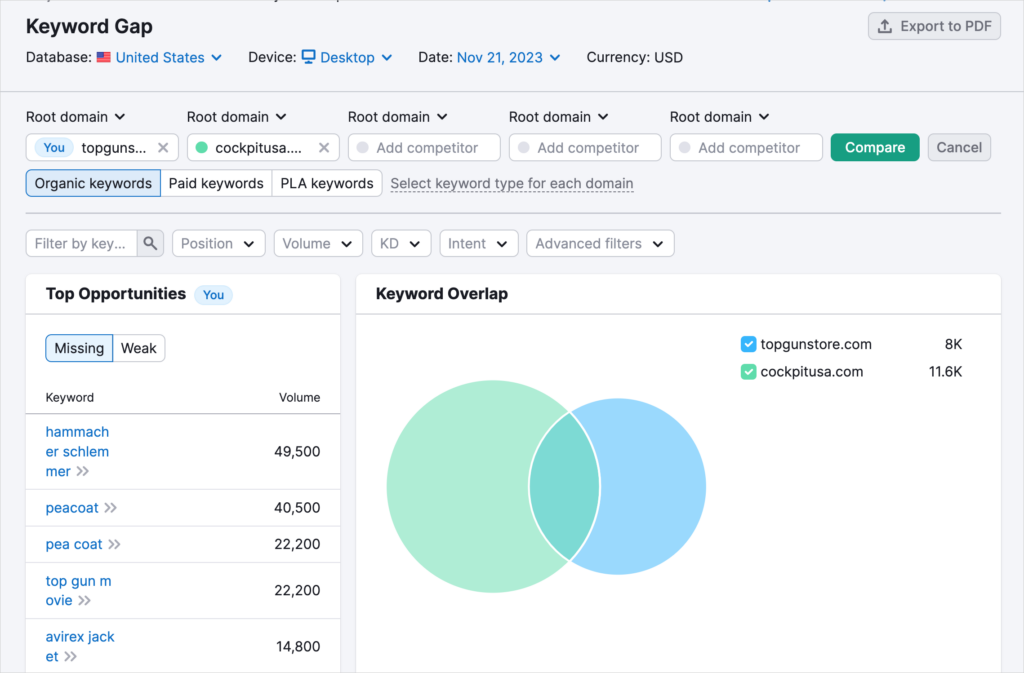
Above that diagram, click on the Intent filter and tick the Commercial and Transactional boxes.

Then click the KD filter and select Easy or Very Easy.
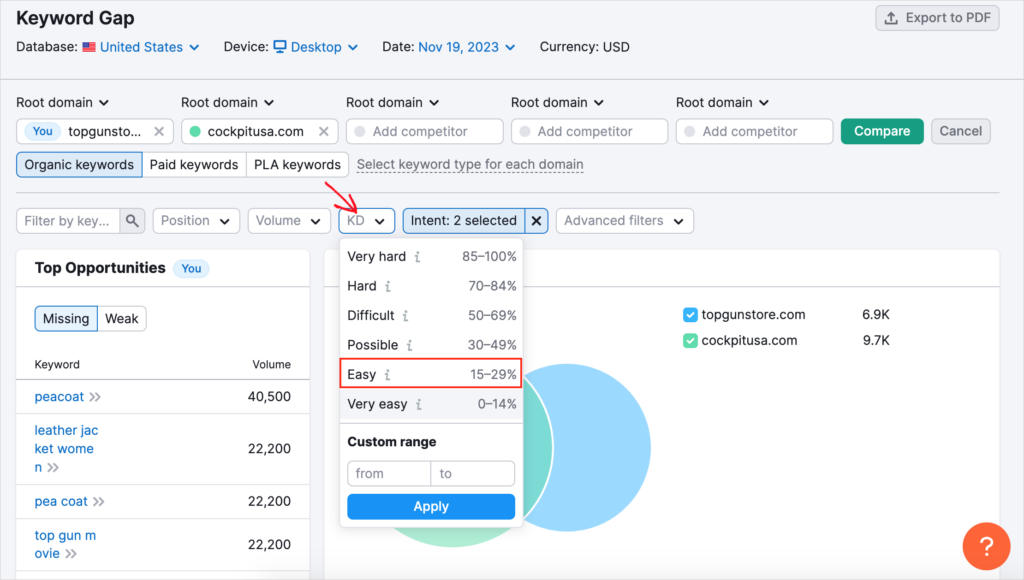
Now, scroll below the Venn diagram and click the Untapped filter.
This will display keywords that your competition is ranking for, but you aren’t.
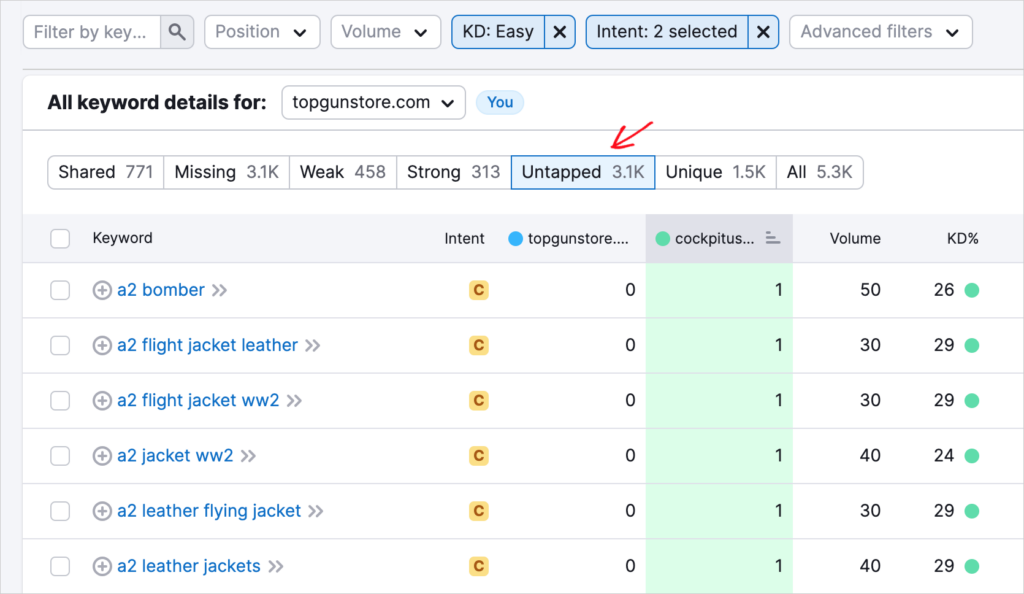
In the screengrab above, we see variations of the A2 jacket, which CockpitUSA.com ranks #1 for.
Scroll down in Semrush, and you’ll find over 3,000 untapped keywords.
Remember, these are untapped keywords that are easy rank for and signal commercial or transactional intent.

Create a keyword list: Tick the box next to keywords in Semrush to save them to a list.
Once you’ve selected some keywords to create content on, what’s next?
Create a high-quality page on your chosen keyword. Remember: content quality is the #1 ranking factor.
To ensure your content ranks as high as possible, optimize your page before publishing. This is particularly important when you’re targeting your competition’s keywords.
Learn more in Keyword Gap Analysis: Increase Market Share With this SEO Tactic.
Optimize Your Content Before Publishing
The easiest way for WordPress users to optimize their content is to use an SEO plugin.
We recommend All in One SEO (AIOSEO). This beginner-friendly plugin will show you exactly how to improve your SEO.
All in One SEO is an established plugin with thousands of 5-star reviews on WordPress.org. Currently, over 3 million people are using it.

After you download and install the plugin, All in One SEO (AIOSEO) will analyze your page content.
While logged into WordPress, you’ll find the plugin’s recommendations in a sidebar.
As you click on each item, like Basic SEO or Readability, you’ll get specific action steps for improvement.

Simply follow the instructions, and you’ll see your SEO score go up.

We use AIOSEO to optimize our pages before publishing. And it takes about 5-10 minutes for us to do this.
Adopting this simple but consistent SEO discipline can transform your site’s performance and accelerate achievement of your website goals.
Here are just a few of the available features.
- Sitemap Generator: Get 100% maintenance-free sitemaps created according to Google’s recommendations.
- Automated On-Page SEO checks: See exactly how to improve SEO on a page. As you act on the recommendations, your SEO score goes up.
- Schema Generator: Easily add schema markup to pages. This can help you rank for more keywords and get more traffic.
- AI-Powered Link Assistant: Speed up internal linking, which can improve your rankings and drive more traffic to your site.
- SEO revisions: See how changes you make impact your rankings.
- Rank Tracking: See how you’re ranking in Google without leaving WordPress. This SEO Statistics feature is an integration with Google Search Console.
- Google Algorithm Updates: See the impact of Google algorithm changes on your content.
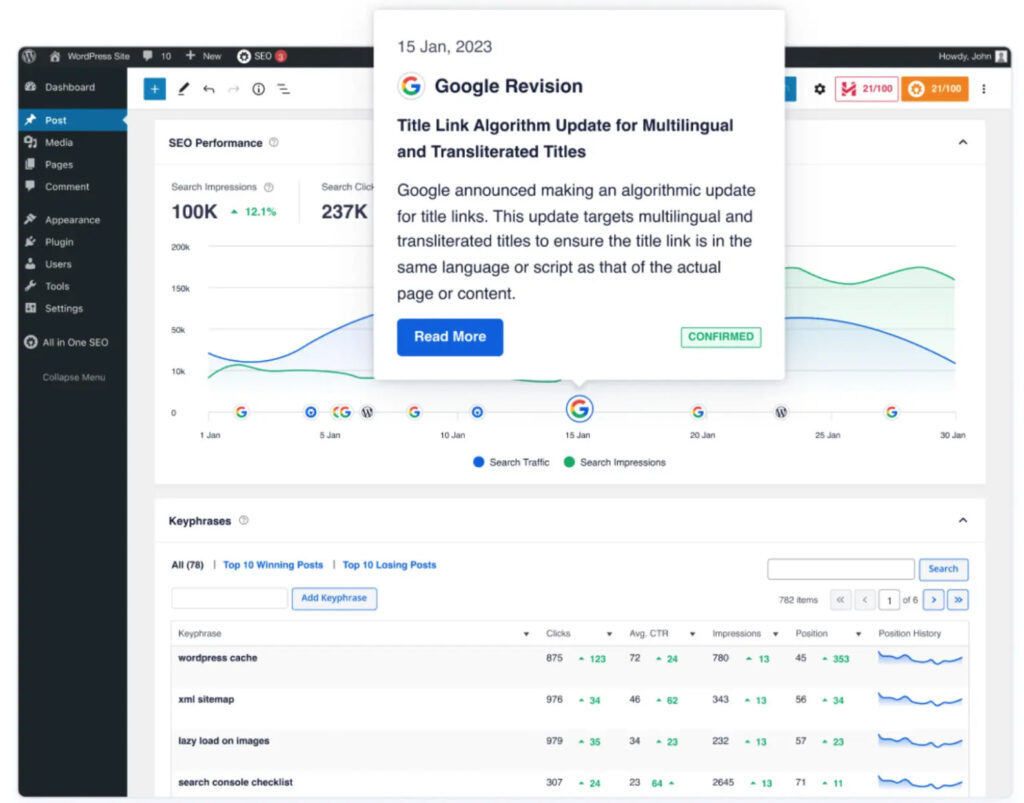
Q&A on Low Competition Keywords and SEO
Should I target low competition keywords?
Because low competition keywords are easy to rank for, targeting them is typically the only way a new site can rank.
But low competition keywords aren’t just for beginners. Many established brands target low competition keywords that have commercial and transactional intent because this is an effective way to get highly qualified traffic that converts.
This is also a way to keep the cost of customer acquisition down and increase the ROI of SEO.
What are high-competition keywords?
High-competition keywords are keywords that are difficult to rank for. These keywords are often broad and vague. And they’re often high volume keywords. Examples are “car insurance” or “superfoods.” Typically, the sites that rank for these keywords are authoritative sites with impressive backlink profiles.
What’s a domain authority score?
Keyword research tools like Ahrefs and Semrush provide proprietary domain scores that are are measure of a website’s competitiveness and authority.
Semrush calls this a “domain authority” score while Ahrefs uses the term “domain rating.” These scores are not always a proxy for quality and competitiveness, but because they’re heavily based on backlinks analysis, they often serve as a useful measure.

Are there any free tools for finding low competition keywords?
There are quite a few free keyword research tools, including Google’s Keyword Planner. You can even use Chrome Incognito to discover search intent, get new keyword ideas, and get an approximate idea of who’s ranking for a particular keyword.
Check out our overview of free SEO tools. Keep in mind that none of these free tools provide all the features that Ahrefs or Semrush does. And many are designed to get you to sign up for a paid plan.
SEO Resources for Ranking Higher
As you use your keyword research skills to attract valuable organic traffic, you’ll likely want to learn more.
Here are some curated resources that will help you see what’s possible for you as you hone your SEO strategy.
- 7 SEO Secrets the Pros Use to Grow Revenue
- How to Steal Your Competitors’ Keywords
- New and Creative Ways to Generate Leads Fast
- The Ultimate Link Building Guide
- Keyword Difficulty in SEO: What is and How to Use It
- SEO vs. Social Media: How do Their Roles Differ in Digital Marketing?
- Best On-Page SEO Tools for WordPress
Be sure to bookmark this blog and subscribe to our YouTube Channel. Every week we publish new step-by-step tutorials.
And follow us on X (Twitter), LinkedIn, or Facebook to stay in the loop.
Disclosure: Our content is reader-supported. This means if you click on some of our links, then we may earn a commission. We only recommend products that we believe will add value to our readers.
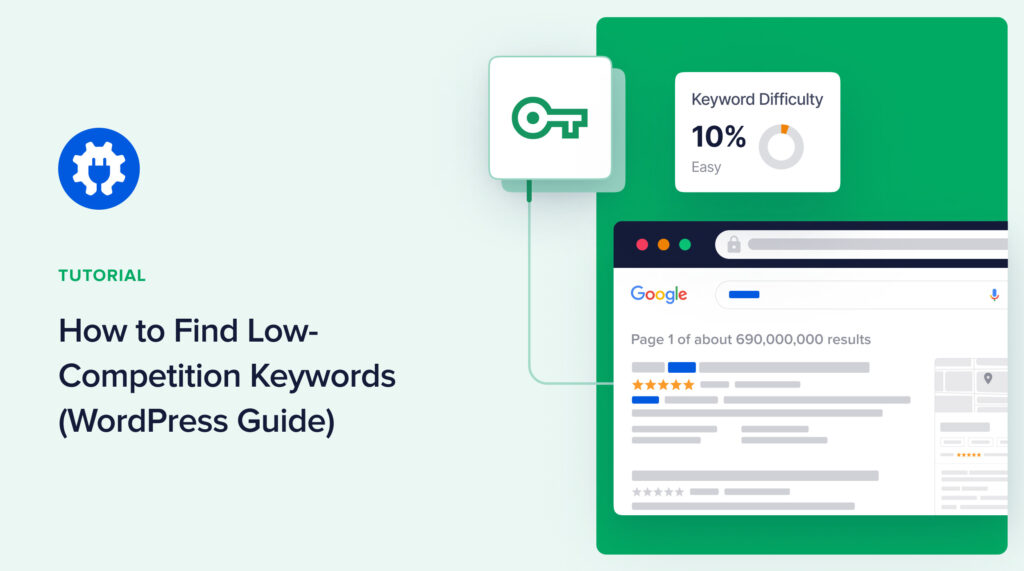

Great tips on identifying low competition keywords! Loved the practical steps and tools mentioned. It’s amazing how the right keywords can boost conversions significantly.